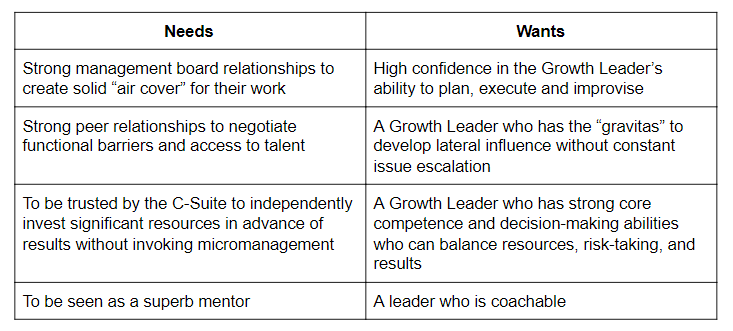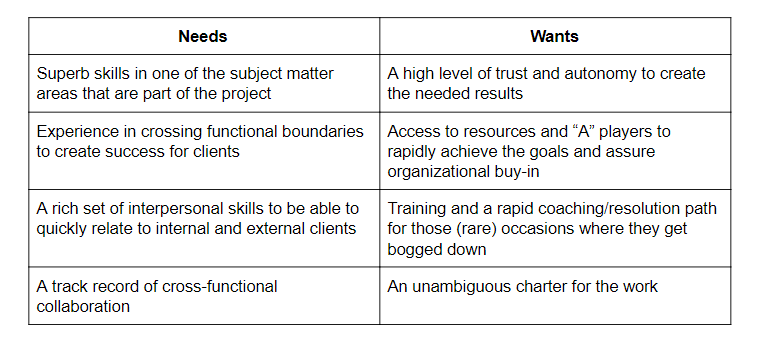 What’s the net present value of each of these two opportunities?
What’s the net present value of each of these two opportunities?
Scenario one: Your sales team alerted you first: one of your top ten clients was about to move to a new supplier that offered a dramatically better service. You pulled together the right group of subject matter experts and you got them in the room with the account manager. Insights began to flow and soon you had agreed on the scope of a new path.
Scenario two: Your R&D team found it first: a nascent new path of joining two dissimilar materials. The more your team looked at it, the more profound the implications, the faster the computational speeds and the much better conductivity to remove heat. Now that you’ve built an ironclad patent portfolio, it’s time to move to implementation.
The answer? Zero.
Until these insights are reduced to practice and all the problems have been solved, they remain “high potential.” It’s the “murky middle” that we rarely talk about: taking high potential opportunities and turning them into high reality earnings and value on the balance sheet.
As a masters degree engineer, I love to get my tech on as much as the next person, however, my experience with clients is that while each of these project types will run into tech issues, what will make or break their success is human and organizational issues. When doing post-mortems with the leadership teams, what primarily comes to the top of the list are issues around decision making, focus, and collaboration.
So, knowing this, how do we avoid these issues? And what is the smallest unit of the organization that we can form to build successful breakout teams? In the work I do with client firms, I have zeroed in on three roles that need to work in concert to enable powerful and repeatable success.
Can you do it with less than three? The answer is, of course, yes, but at a cost. What I’m sharing with you here is the smallest unit of sustainable growth production, where you can expect a team to be activated, make its goals and then be ready to reassemble and do it again. Try to do this with simply heroic leadership and be ready to lose big portions of your group on every cycle.
So, what are these three roles?
#1: Executive Sponsor
This person is the designated senior lead. Typically a member of the management board, this person is accountable to the senior team for sourcing the Growth Leader and assuring that she receives the needed personnel, access and funding to get the breakout work completed. For more on sponsorship, see posts here, here and here .
When the needs and wants of the executive sponsor are met, it sets them up to have the confidence to build real scale into the firm. When they can balance strategic guidance, oversight, and results, it allows them to take a portfolio approach to growth. It is then that the firm can enjoy geometric growth.
#2: Growth Leader
This is the implementation team’s “runway level” operational leader. This person leads the team through structuring the approach, sourcing its personnel, planning and guiding the team through the myriad of challenges faced by breakthrough programs. This person is usually a strong functional leader who is ready for a significant developmental challenge. For more on becoming a growth leader, see these posts here, here and here.
Growth Leaders who enjoy this level of support become substantial assets for their firm and are able to take on challenging new projects with humility and confidence. Having bench strength in this area is key to the growth and renewal of firms that may be plateauing in their core markets.
#3: HR Support & Development Partner
This is the often unacknowledged key partner in the sustainable success of strategic growth programs. While technical failures do occur, much more frequently these efforts fail due to insufficient resources applied to coach, team dynamics and leadership mentoring. Having a strong HR mentor and third-party support is key to making these efforts sustainable. For more on the role of the HR Partner, see posts here, here and here.
When this goes well, it’s hard to see what’s truly going on to build skills in the firm. Upon closer examination, you’ll see a relationship much like the coal car that was the source of energy for the steam engine. When the Sponsor/Growth Leader pair needs the tools and techniques to effect true high-performance teams, the HR partner is right there as a trusted advisor, coach, and resource provider. This leader hands the Sponsor/Growth Leader an umbrella just before it rains. This person is also the one that knows the strategic talent in the firm and where they are on their developmental journey. Lastly, they are good networkers and can bring great external resources to the table when needed.
A Dynamic Relationship
There is an old adage in flying that a good landing is one you walk away from, while a superb landing is one when you can use the airplane over again. Unfortunately, after many breakout initiatives, participants are burned out and never regain their former spirit.
While we clearly want each program to be successful, for a firm to thrive, these breakthrough efforts need to be sustainable. To do that we need these three roles to function in a way that not only produces business results, but also results in a powerful “lab” for emerging leaders to develop powerful skills.
I have had the privilege to come alongside dozens of executives, growth teams and Growth Leaders as a right-hand strategic advisor. If you’d like to explore how you or your firm would benefit from an investment to move from strong ideas to strong results, please reach out via 847-651-1014 or use this link to set up a short call.
Related posts you can benefit from…



